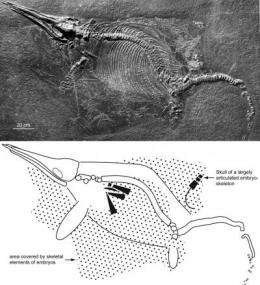Exploding dinosaur hypothesis implodes

Exploding carcasses through putrefaction gases - this is how science explained the mysterious bone arrangements in almost fully preserved dinosaur skeletons for decades. Now a Swiss-German research team has proved that these carcasses sank to the seabed and did not explode. The sedimentologists and paleontologists from the universities of Zurich and Basel thus dispel the myth of exploding marine reptiles.
The pregnant ichthyosaur female from Holzmaden (Germany) that perished 182 million years ago puzzled researchers for quite some time: The skeleton of the extinct marine reptile is almost immaculately preserved and the fossilized bones of the mother animal lie largely in their anatomical position. The bones of the ichthyosaur embryos, however, are a different story: For the most part, they lie scattered outside the body of the mother. Such peculiar bone arrangements are repeatedly found in ichthyosaur skeletons. According to the broadly accepted scientific doctrine, this is the result of exploding carcasses: Putrefaction gases produced during the decomposition process cause the carcass to swell and burst. Through such explosions, even the bones of embryos can supposedly be ejected out of the body. Based on an elaborate series of measurements and an analysis of the physical-biological parameters, however, a research team of sedimentologists, paleontologists and forensic scientists has now managed to dispel the myth of exploding dinosaur carcasses.
Putrefaction gas pressure not high enough
In order to gauge the pressure of the particular gases that can actually develop inside a putrefying ichthyosaur, the researchers sought comparative models and found one in human corpses: Humans and many ichthyosaur species have a similar size range. Consequently, the formation of similar amounts of putrefaction gas can be expected during decomposition. At the Institute of Forensic Medicine in Frankfurt, Germany, a manometer was inserted into the abdominal cavity through the umbilicus in one hundred corpses.The putrefaction gas pressures measured were only 0.035 bar. In the case of the ichthyosaur carcasses that came to rest below 50 to 150 meters of water, however, putrefaction gas pressures of over five to 15 bar would have been necessary to cause an explosion. According to Zurich paleontologist Christian Klug, gas pressures of this dimension and therefore actual explosions are impossible: "Large vertebrates that decompose cannot act as natural explosive charges." And he is convinced: "Our results can be extended to lung-breathing vertebrates in general."
What actually happened 182 million years ago
According to the researchers, the fate of ichthyosaur carcasses can be reconstructed as follows: Normally, the bodies sank to the seabed immediately post mortem. In very deep, hospitable waters, they were broken down completely through putrefaction,scavengers, bone-destroying organisms and dissolving processes. In shallower water (up to 50 meters) and a temperature of over four degrees Celsius, however, the corpses often rose back to the surface on account of the putrefaction gases accumulating inside the body. At the surface, exposed to the waves and scavengers, they decomposed within anything from a few days to weeks and the bones were scattered over a wide area on the seabed as they sank.
Ichthyosaur skeletons only remained preserved more or less in their anatomical position under very special circumstances: A lack of oxygen, medium water depths and insignificant bottom water currents. Because only then were the putrefaction gases compressed strongly enough through the high water pressure and dissolved in the bodily fluids, and the carcasses not completely broken down due to a lack of scavengers. The carcass of the ichthyosaur female from Holzmaden thus sank to the bottom of the sea, which was up to 150 meters deep, where it decomposed. In doing so, the decomposed embryo skeletons were transported out of the body of the mother by minor currents at the seabed.
More information: Achim G. Reisdorf, Roman Bux, Daniel Wyler, Mark Benecke, Christian Klug, Michael W. Maisch, Peter Fornaro, Andreas Wetzel (2012): Float, explode or sink: post-mortem fate of lung-breathing marine vertebrates. In: Michael Wuttke & Achim G. Reisdorf (eds): Taphonomic processes in terrestrial and marine environments. – Palaeobiodiversity and Palaeoenvironments, 92(1): 67-81. DOI: 10.1007/s12549-011-0067-z
Provided by University of Zurich



















